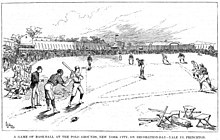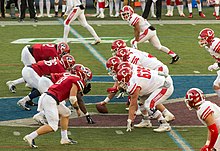Ivy League
Before the 2000s, many of the Ivy League championships for men's and women's cross country, indoor and outdoor track & field, and swimming & diving were formatted as invitationals that many schools across the eastern United States would attend.
The supposed "IV League" was formed over a century ago and consisted of Harvard, Yale, Princeton, and a fourth school that varies depending on who is telling the story.
[56][57][58] However, it is clear that Harvard, Princeton, Columbia, and Yale met on November 23, 1876, at the so-called Massasoit Convention to decide on uniform rules for the emerging game of American football, which rapidly spread.
"Ivy League" is sometimes used as a way of referring to an elite class, even though institutions such as Cornell University were among the first in the United States to reject racial and gender discrimination in their admissions policies.
Romeyn Berry, Cornell's manager of athletics, reported the situation in January 1936 as follows: I can say with certainty that in the last five years—and markedly in the last three months—there has been a strong drift among the eight or ten universities of the East which see a good deal of one another in sport toward a closer bond of confidence and cooperation and toward the formation of a common front against the threat of a breakdown in the ideals of amateur sport in the interests of supposed expediency.
The seven colleges involved fall naturally together by reason of their common interests and similar general standards and by dint of their established national reputation they are in a particularly advantageous position to assume leadership for the preservation of the ideals of intercollegiate athletics.
Harvard's team, "The Oneida", won the race and was presented with trophy black walnut oars from then-presidential nominee General Franklin Pierce.
On January 11, 1937, the athletic authorities at the schools rejected the "possibility of a heptagonal league in football such as these institutions maintain in basketball, baseball and track."
The movie Animal House includes a satiric version of the formerly common visits by Dartmouth men to Massachusetts to meet Smith and Mount Holyoke women, a drive of more than two hours.
As noted by Irene Harwarth, Mindi Maline, and Elizabeth DeBra, "The 'Seven Sisters' was the name given to Barnard, Smith, Mount Holyoke, Vassar, Bryn Mawr, Wellesley, and Radcliffe, because of their parallel to the Ivy League men's colleges.
[93] As a consequence of the pandemic, an unprecedented number of student athletes in the Ivy League either transferred to other schools, or temporarily unenrolled in hopes of maintaining their eligibility to play post-pandemic.
[93] In February 2021 it was reported that Yale declined a multi-million dollar offer from alum Joseph Tsai to create a sequestered "bubble" for the lacrosse team.
[94] Following the Black Lives Matter protests in 2020, the Ivy League Conference committed itself to uphold "diversity, equity, and inclusion," to combat racism and homophobia.
[96][97] The lawsuit claims that the agreement constitutes price-fixing in violation of the Sherman Antitrust Act of 1890, and in effect raises the cost of Ivy League education for student athletes.
The universities collaborate academically through the IvyPlus Exchange Scholar Program, which allows students to cross-register at one of the Ivies or another eligible school such as Berkeley, Chicago, MIT, and Stanford.
Abolitionist Elizabeth Buffum Chase wrote in her book Anti Slavery Reminiscences about "a lad of rare excellence and attainments [who] was refused an examination for admission by the authorities of Brown University on account of the color of his skin."
Yale's Edward Bouchet, was the first Black person (a) elected to Phi Beta Kappa in the US in 1874 and (b) to earn a Ph.D. from any American university, completing his dissertation in physics in 1876.
[156] These efforts also prompted internal University action, such as the creation of Cornell's Committee on Special Educational Projects (COSEP), an organization aimed to recruit and support Black students.
[116] Demonstrations at Harvard and Columbia took the form of occupations and non-violent sit-ins that were often subject to forceful removal by local police called by University administrators.
[174] In response to racially charged incidents across the country and prompting from student activists, Ivy League universities have removed and renamed campus landmarks.
Press and Brooks Brothers, both being pioneers in preppy fashion, had stores on Ivy League school campuses, including Harvard, Yale, and Princeton.
Some typical preppy styles also reflect traditional upper class New England leisure activities, such as equestrian, sailing or yachting, hunting, fencing, rowing, lacrosse, tennis, golf, and rugby.
Vacationing in Palm Beach, Florida, long popular with the East Coast upper class, led to the emergence of bright colors combinations in leisure wear seen in some brands such as Lilly Pulitzer.
In 1936, sportswriter John Kieran noted that student editors at Harvard, Yale, Columbia, Princeton, Cornell, Dartmouth, and Penn were advocating the formation of an athletic association.
In urging them to consider "Army and Navy and Georgetown and Fordham and Syracuse and Brown and Pitt" as candidates for membership, he exhorted: It would be well for the proponents of the Ivy League to make it clear (to themselves especially) that the proposed group would be inclusive but not "exclusive" as this term is used with a slight up-tilting of the tip of the nose.
[195] Columnist Russell Baker opined that "Voters inclined to loathe and fear elite Ivy League schools rarely make fine distinctions between Yale and Harvard.
)[207] In the 2011–2012 academic year, students qualifying for Pell Grants (federally funded scholarships on the basis of need) constituted 20% at Harvard, 18% at Cornell, 17% at Penn, 16% at Columbia, 15% at Dartmouth and Brown, 14% at Yale, and 12% at Princeton.
To promote diversity and inclusion, student-athletes are required to have their gender pronouns listed on their roster pages on the athletic websites for most Ivy League schools.
Harvard won its first title of either variety in 2011, losing a dramatic play-off game to Princeton for the NCAA tournament bid, then rebounded to win outright championships in 2012, 2013, and 2014.
[246][247] This phenomenon of a finale contest at a neutral site for the national title created a social occasion for the society elite of the metropolitan area akin to a Super Bowl in the era prior to the establishment of the NFL in 1920.



















